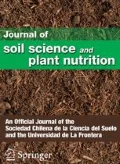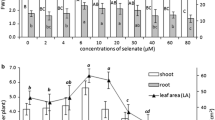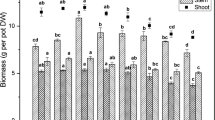Abstract
Selenium (Se) is microelement beneficial to plants and essential to animals and humans. Supply of Se shows positive effects on plant growth, but high concentrations affect its growth. This study is based on the hypothesis that nutritional disorder and oxidative stress induced by toxic levels of selenium maintain a close correlation with inhibition of photosynthesis net and reduced growth in lettuce plants. In this study, we investigated impact of Se toxicity on gas exchange, oxidative stress indicators, nutritional status, and growth of lettuce plants. Two sources and ten selenium concentrations were evaluated in lettuce according to a completely randomized experimental design in a factorial scheme with two selenium sources (selenite and selenate) and ten selenium concentration (0, 2, 4, 6, 8, 16, 32, 64, 96, 128 μM). Results show that reduction in leaf area and shoot dry matter was high when selenite was supplied to plants. It was achieved due to oxidative stress and nutritional disorder that affected photosynthesis, which resulted in low photosynthesis net. These results were reinforced by strong correlation of photosynthesis with essential nutrient contents and indicators of oxidative stress in plants treated with selenite. However, photosynthesis net was increased with 8 μM concentration of selenate. Lettuce growth was reduced due to oxidative stress and nutritional disorder. The results of this study contribute to clarifying negative modulation of photosynthesis net by higher selenate or selenite concentrations in lettuce plants through growth analysis, nutritional composition, oxidative stress indicators, and gas exchange. The strong or very strong negative correlation between photosynthesis net and oxidative stress indicators (superoxide, peroxide and malondialdehyde), photosynthesis net and chlorophyll a, photosynthesis net, and selenium content support the hypothesis of this study in which selenium-induced damage to the photosynthetic apparatus reduces the growth of lettuce. These results show new evidence on the mechanism of action of selenium toxicity on the photosynthetic machinery of lettuce plants. In addition, the results found show that lettuce plants respond differently to the source and concentration of selenium, with symptoms of toxicity manifesting even in the short exposure time of lettuce plants.







Similar content being viewed by others
Data Availability
Data are available upon request to corresponding author.
Abbreviations
- B:
-
Boron
- Ca :
-
Calcium
- Chl a:
-
Chlorophyll a
- Chl b:
-
Chlorophyll b
- Ci/Ca:
-
Relation between internal and external CO2
- Cu:
-
Copper
- E:
-
Transpiration
- Fe:
-
Iron
- Fv/Fm:
-
Maximal quantum yield of PSII photochemistry
- gs:
-
Stomatal conductance
- H2O2 :
-
Hydrogen peroxide
- K:
-
Potassium
- LA:
-
Leaf area
- MDA:
-
Malondialdehyde
- Mg:
-
Magnesium
- Mn:
-
Manganese
- N:
-
Nitrogen
- O2 :
-
Superoxide
- P:
-
Phosphorous
- Pn:
-
Photosynthesis net
- RDM:
-
Root dry matter
- RFM:
-
Root fresh matter
- r:
-
Correlation coefficient
- S:
-
Sulfur
- SeO42−:
-
Selenate
- SeO32−:
-
Selenite
- Se–C:
-
Selenium concentration
- Se–S:
-
Selenium source
- Se-C × Se-S:
-
Selenium concentration and source interaction
- SDM:
-
Shoot dry matter
- SFM:
-
Shoot fresh matter
- Zn:
-
Zinc
References
Abogadallah GM (2010) Antioxidative defense under salt stress. Plant Signal Behav 5:369–374
Alexieva V, Sergiev I, Mapelli S, Karanov E (2001) The effect of drought and ultraviolet radiation on growth and stress markers in pea and wheat. Plant Cell Environ 24:1337–1344. https://doi.org/10.1046/j.1365-3040.2001.00778.x
Alves LT, Monteiro CC, Carvalho RF, Ribeiro PC, Tezotto T, Azevedo RA, Gratão PL (2017) Cadmium stress related to root-to-shoot communication depends on ethylene and auxin in tomato plants. Environ Exp Bot 134:102–115. https://doi.org/10.1016/j.envexpbot.2016.11.008
Andrade FR, Silva GN, Guimarães KC, Barreto HBF, Souza KRD, Guilherme LRG, Faquin V, Reis AR (2018) Selenium protects rice plants from water deficit stress. Ecotoxicol Environ Saf 164:562–570
Barbosa JC, Maldonado Júnior W (2009) Software AgroEstat: Sistema de análises estatísticas de ensaios agronômicos. Universidade Estadual Paulista, Faculdade de Ciências Agrárias e Veterinárias, Câmpus de Jaboticabal, Brasil
Bataglia OC, Furlani AMC, Teixeira JPF, Furlani PR, Gallo JR (1983) Métodos de análise química de plantas. Campinas: Instituto Agronômico. 48p. (Boletim Técnico, 78)
Berry MJ, Banu L, Larsen PR (1991) Type I iodothyronine deiodinase is a selenocysteine-containing enzyme. Nature 349:438–440
Bianco AC, Salvatore D, Gereben B, Berry MJ, Larsen PR (2002) Biochemistry, cellular and molecular biology, and physiological roles of the iodothyronine selenodeiodinases. Endocr Rev 23:38–89. https://doi.org/10.1210/edrv.23.1.0455
Bo L, Zhong-hua B, Qi-hang Y, Jun W, Rui-feng C, Kun L, Wen-ke L, Yi Z, Hui F, Yun-xin T (2018) The positive function of Se supplementation on reducing nitrate accumulation in hydroponic lettuce (Lactuca sativa L.). J Integr Agric 17:837–846. https://doi.org/10.1016/S2095-3119(17)61759-3
Bolhàr-Nordenkampf HR, Long SP, Baker NR, Örquist G, Schreiber U, Lechner EG (1989) Chlorophyll fluorescence as probe of the photosynthetic competence of leaves in the field: a review of current instrument. Funct Ecol 3:497–514
Davey MW, Stals E, Panis B, Keulemans JK, Swennen RL (2005) High-throughput determination of malondialdehyde in plant tissues. Anal Biochem 347:201–207. https://doi.org/10.1016/j.ab.2005.09.041
Diao M, Ma L, Wang J, Cui J, Fu A, Liu H (2014) Selenium Promotes the growth and photosynthesis of tomato seedlings under salt stress by enhancing chloroplast antioxidant defense system. J Plant Growth Regul 33:671–682. https://doi.org/10.1007/s00344-014-9416-2
Djanaguiraman M, Devi DD, Shanker AK, Sheeba JA, Bangarusamy U (2005) Selenium - an antioxidative protectant in soybean during senescence. Plant Soil 272:77–86. https://doi.org/10.1007/s11104-004-4039-1
Doke N (1983) Involvement of superoxide anion generation in the hypersensitive response of potato tuber tissues to infection with an incompatible race of phytophtorhora infestans and to the hyphal wall components. Physiol Plant Pathol 23:345–357. https://doi.org/10.1016/0048-4059(83)90019-X
Durán P, Viscardi S, Acuña JJ, Cornejo P, Azcón R, Mora ML (2018) Endophytic selenobacteria and arbuscular mycorrhizal fungus for selenium biofortification and Gaeumannomyces graminis biocontrol. J Soil Sci Plant Nutr 18:1021–1035
Garousi F, Kovács B, Andrási D, Veres S (2016) Selenium phytoaccumulation by sunflower plants under hydroponic conditions. Water Air Soil Pollut 227:382. https://doi.org/10.1007/s11270-016-3087-5
Gigolashvili T, Kopriva S (2014) Transporters in plant sulphur metabolism. Front Plant Sci 5:422. https://doi.org/10.3389/fpls.2014.00442
Gupta M, Gupta S (2017) An overview of selenium uptake, metabolism, and toxicity in plants. Front Plant Sci 7:2074. https://doi.org/10.3389/fpls.2016.02074
Han D, Li X, Xiong S, Tu S, Chen Z, Li J, Xie Z (2013) Selenium uptake, speciation and stressed response of Nicotiana tabacum L. Environ Exp Bot 95:6–14. https://doi.org/10.1016/j.envexpbot.2013.07.001
Hawrylak-Nowak B (2008) Effect of selenium on selected macronutrients in maize plants. J Elem 13:513–519
Hawrylak-Nowak B, Matraszek R, Pogorzelec M (2015) The dual effects of two inorganic selenium forms on the growth, selected physiological parameters and macronutrientes accumulation in cucumber plants. Acta Physiol Plant 37:41. https://doi.org/10.1007/s11738-015-1788-9
He J, Quin L, Lee SK (2013) Root-zone CO2 and root-zone temperature effects on photosynthesis and nitrogen metabolism of aeroponically grown lettuce (Lactuca sativa L.) in the tropics. Photosynthetica 51:330–340. https://doi.org/10.1007/s11099-013-0030-5
Heath RL, Packer L (1968) Photoperoxidation in isolated chloroplasts: I. kinetics and stoichiometry of fatty acid peroxidation. Arch Biochem Biophys 125:189–198. https://doi.org/10.1016/0003-9861(68)90654-1
Hoagland DR, Arnon DI (1950) The water-culture method for growing plants without soil. California Agricultural Experiment Station, Circular-347
Hsu F-C, Wirtz M, Heppel SC, Bogs J, Krämer U, Khan MS, Bub A, Hell R, Rausch T (2011) Generation of Se-fortified broccoli as functional food: impact of Se fertilization on S metabolism. Plant Cell Environ 34:192–207. https://doi.org/10.1111/j.1365-3040.2010.02235.x
Jiang C, Zu C, Shen J, Shao F, Li T (2015) Effects of selenium on the growth and photosynthetic characteristics of flue-cured tobacco (Nicotiana tabacum L.). Acta Soc Bot Pol 84:71–77. https://doi.org/10.5586/asbp.2015.006
Köhrle J, Jakob F, Contempre B, Dumont JE (2005) Selenium, the thyroid, and the endocrine system. Endocr Rev 26:944–984. https://doi.org/10.1210/er.2001-0034
Kostopoulou P, Parissi ZM, Abraham EM, Karatassiou M, Kyriazopoulos AP, Barbayiannis N (2015) Effect of selenium on mineral content and nutritive value of Melilotus officinalis l. J Plant Nutr 38(1849–1861):2015
Kumar D, Yusuf MA, Singh P, Sardar M, Sarin NB (2014) Histochemical detection of superoxide and H2O2 accumulation in brassica juncea seedlings. Biol-protocol 4:1–5. https://doi.org/10.21769/BioProtoc.1108
Lehotai N, Lyubenova L, Schröder P, Feigl G, Ördög A, Szilágyi K, Erdei L, Kolbert Z (2016) Nitro-oxidative stress contributes to selenite toxicity in pea (Pisum sativum L). Plant Soil 400:107–122. https://doi.org/10.1007/s11104-015-2716-x
Li HF, McGrath SP, Zhao FJ (2008) Selenium uptake, translocation and speciationin wheat supplied with selenate or selenite. New Phytol 178:92–102. https://doi.org/10.1111/j.1469-8137.2007.02343.x
Lichtenthaler HK (1987) Chlorophylls and carotenoids: pigment photosynthetic biomembranes. Methods Enzymol 148:362–385. https://doi.org/10.1016/0076-6879(87)48036-1
Łukaszewicz S, Politycka B, Smoleń S (2019) Accumulation of selected macronutrients and tolerance towards selenium of garden pea treated with selenite and selenate. J Elem 1:245–256. https://doi.org/10.5601/jelem.2018.23.1.1650
Maathuis FJM (2009) Physiological functions of mineral macronutrientes. Curr Opin Plant Biol 12:250–258. https://doi.org/10.1016/j.pbi.2009.04.003
Marschener H (1995) Mineral nutrition of higher plants, ed. Horst Marschner, 2nd edn. Academic Press, San Diego
Matraszek R, Hawrylak-Nowak B (2009) Macronutrients accumulation in useable parts of lettuce as affected by nickel and Se concentrations in nutrient solution. Fresenius Environ Bull 18:1059–1065
Medeiros CD, Ferreira Neto JRC, Oliveira MT, Rivas R, Pandolfi V, Kido EA, Baldani JI, Santos MG (2014) Photosynthesis, antioxidant activities and transcriptional responses in two sugarcane (Saccharum officinarum L.) cultivars under salt stress. Acta Physiol Plant 36:447–459. https://doi.org/10.1007/s11738-013-1425-4
Miller G, Suzuki N, Ciftci-Yilmaz SRM (2010) Reactive oxygen species homeostasis and signalling during drought and salinity stresses. Plant Cell Environ 33:453–467. https://doi.org/10.1111/j.1365-3040.2009.02041.x
Mittler R (2002) Oxidative stress, antioxidants and stress tolerance. Trends Plant Sci 7:405–410. https://doi.org/10.1016/S1360-1385(02)02312-9
Mulabagal V, Ngouajio M, Nair A, Zhang Y, Gottumukkala AL, Nair MG (2010) In vitro evaluation of red and green lettuce (Lactuca sativa) for functional food properties. Food Chem 118:300–306
Narváez-Ortiz WA, Martínez-Hernández M, Fuentes-Lara LO, Benavides-Mendoza A, Valenzuela-García JR, González-Fuentes JÁ (2018) Effect of selenium application on mineral macro- and micronutrients and antioxidant status in strawberries. J Appl Bot Food Qual 91:321–331
Niki E (2008) Lipid peroxidation products as oxidative stress biomarkers. BioFactors 34:171–180
Padmaja K, Prasad DD, Prasad AR (1990) Selenium as a novel regulator of porphyrin biosynthesis in germinating seedlings of mung bean (Phaseolus vulgaris). Biochem Int 22:441–446
Pílon-Smits EAH (2015) Selenium in plants. In: Luettge U (ed) Springer - Verlag. Gemany, Heidelberg, pp 93–107
Pílon-Smits EAH, Quinn CF, Tapken W, Malagoli M, Schiavon M (2009) Physiological functions of beneficial elements. Curr Opin Plant Biol 12:267–274
Ramos SJ, Faquin V, Guilherme LRG, Castro EM, Ávila FW, Carvalho GS, Bastos CEA, Oliveira C (2010) Selenium biofortification and antioxidant activity in lettuce plants fed with selenate and selenite. Plant Soil Environ 56:584–588
Raij BV, Cantarella H, Quaggio JA, Furlani AMC (1997) Recomendações de adubação e calagem para o Estado de São Paulo. Instituto Agronômico/Fundação IAC, Campinas, 285p
Ribeiro DM, Júnior DDS, Cardoso FB, Martins AO, Silva WA, Nascimento VL, Araújo WL (2016) Growth inhibition by Se is associated with changes in primary metabolism and nutrient levels in Arabidopsis thaliana. Plant Cell Environ 39:2235–2246. https://doi.org/10.1111/pce.12783
Ríos JJ, Blasco B, Leyva R, Sanchez-Rodriguez E, Rubio-Wilhelmi MM, Romero L, Ruiz JM (2013) Nutritional balance changes in lettuce plant grown under different doses and forms of Se. J Plant Nutr 36:1344–1354. https://doi.org/10.1080/01904167.2013.790427
Sabatino L, Ntatsi G, Iapichino G, D’Anna F, De Pasquale C (2019) Effect of selenium enrichment and type of application on yield, functional quality and mineral composition of curly endive grown in a hydroponic system. Agronomy 9:1–15
Saffaryazdi A, Lahouti M, Ganjeali A, Bayat H (2012) Impact of selenium supplementation on growth and selenium accumulation on spinach (Spinacia oleracea L.) plants. Not Bot Horti Agrobo 4:95–100
Saldaña-Sánchez WD, León-Morales JM, López-Bibiano Y, Hernández-Hernández M, Langarica-Velázquez EC, García-Morales S (2019) Effect of V, Se, and Ce on growth, photosynthetic pigments, and total phenol content of tomato and pepper seedlings. J Soil Sci Plant Nutr 19:678–688. https://doi.org/10.1007/s42729-019-00068-1
Saleem MF, Kamal MA, Shahid M, Saleem A, Shakeel A, Anjum AS (2020) Exogenous selenium-instigated physiochemical transformations impart terminal heat tolerance in Bt cotton. J Soil Sci Plant Nutr 20:274–283
Schiavon M, Pilon M, Malagoli M, Pílon-Smits EAH (2015) Exploring the importance of sulfate transporters and ATP sulphurylases for selenium hyperaccumulation - acomparison of Stanleya pinnata and Brassica juncea (Brassicaceae). Front Plant Sci 6:1–13. https://doi.org/10.3389/fpls.2015.00002
Schober P, Boer C, Schwarter LA (2018) Correlation coefficients: appropriate use and interpretation. Anesth Analg 126:1763–1768. https://doi.org/10.1213/ANE.0000000000002864
Sharma P, Jha AB, Dubey RS, Pessarakli M (2012) Reactive oxygen species, oxidative damage, and antioxidative defense mechanism in plants under stressful conditions. J Bot 212:1–26. https://doi.org/10.1155/2012/217037
Sieprawska A, Kornaś A, Filek M (2015) Involvement of selenium in protective mechanisms of plants under environmental stress conditions – review. Acta Biol Cracov Bot 1:9–20. https://doi.org/10.1515/abcsb-2015-0014
Sors TG, Ellis DR, Salt DE (2005) Selenium uptake, translocation, assimilation and metabolic fate in plants. Photosynth Res 86:373–389. https://doi.org/10.1007/s11120-005-5222-9
Spallholz JE (1994) On the nature of Se toxicity and carcinostatic activity. Free Radic Biol Med 17:45–64. https://doi.org/10.1016/0891-5849(94)90007-8
Statwick J, Majestic BJ, Sher AA (2016) Characterization and benefits of selenium uptake by an Astragalus hyperaccumulator and a non-accumulator. Plant Soil 404:345–359. https://doi.org/10.1007/s11104-016-2842-0
Takahashi H, Watanabe-Takahashi A, Smith FW, Blake-Kalff M, Hawkesford MJ, Saito K (2000) The roles of three functional sulfate transporters involved in uptake and translocation of sulphate in Arabidopsis thaliana. Plant J 23:171–182. https://doi.org/10.1046/j.1365-313x.2000.00768.x
Taulavuori E, Hellström EK, Taulavuori K, Laine K (2001) Comparison of two methods used to analyse lipid peroxidation from Vaccinium myrtillus (L.) during snow removal, reacclimation and cold acclimation. J Exp Bot 52:2375–2380. https://doi.org/10.1093/jexbot/52.365.2375
Terry N, Zayed AM, de Souza MP, Tarun AS (2000) Selenium in higher plants. Annu Rev Plant Physiol 51:401–432. https://doi.org/10.1093/aob/mcv180
Tezotto T, Favarin JL, Neto AP, Gratão PL, Azevedo RA, Mazzafera P (2013) Simple procedure for nutrient analysis of coffee plant with energy dispersive X-ray fluorescence spectrometry (EDXRF). Sci Agric 70:263–267 https://doi.org/10.1590/S0103-90162013000400007
Tian M, Hui M, Thannhauser TW, Pan S, Li L (2017) Selenium-induced toxicity is counteracted by sulfur in broccoli (Brassica oleracea L. var. italica). Front Plant Sci 8:1425. https://doi.org/10.3389/fpls.2017.01425
Van Hoewyk D (2013) A tale of two toxicities: malformed selenoproteins and oxidative stress both contribute to Se stress in plants. Ann Bot 112:965–972. https://doi.org/10.1093/aob/mct163
Wallenberg M, Olm E, Hebert C, Björnstedt M, Fernandes AP (2010) Selenium compounds are substrates for glutaredoxins: a novel pathway for Se metabolism and a potential mechanism for Se-mediated cytotoxicity. Biochem J 429:85–93. https://doi.org/10.1042/BJ20100368
White PJ (2016) Se accumulation by plants. Ann Bot 117:217–235. https://doi.org/10.1093/2Faob/2Fmcv180
White PJ, Bowen HC, Parmaguru P, Fritz M, Spracklen WP, Spiby RE, Meacham MC, Mead A, Harriman M, Trueman LJ, Smith BM, Thomas B, Broadley MR (2004) Interactions between selenium and sulphur nutrition in Arabidopsis thaliana. J Exp Bot 55:1927–1937. https://doi.org/10.1093/jxb/erh192
Zayed A, Lytle CM, Terry N (1998) Accumulation and volatilization of different chemical species of selenium by plants. Planta 206:284–292
Zahedi SM, Abdelrahman M, Hosseini MS, Hoveizeh NFH, Tran LSP (2019) Alleviation of the effect of salinity on growth and yield of strawberry by foliar spray of selenium-nanoparticles. Environ Pollut 253:246–258. https://doi.org/10.1016/j.envpol.2019.04.078
Zhang M, Tang S, Huang X, Zhang F, Pang Y, Huang Q, Yi Q (2014) Selenium uptake, dynamic changes in se content and its influence on photosynthesis and chlorophyll fluorescence in rice (Oryza sativa L.). Environ Exp Bot 107:39–45. https://doi.org/10.1016/j.envexpbot.2014.05.005
Zhu YG, Pílon-Smits EAH, Zhao FJ, Williams PN, Meharg AA (2009) Selenium in higher plants: understanding mechanisms for biofortification and phytoremediation. Trends Plant Sci 14:436–442. https://doi.org/10.1016/j.tplants.2009.06.006
Acknowledgments
This work was supported by the Coordenação de Aperfeiçoamento de Pessoal de Nível Superior (CAPES), which granted a master’s degree scholarship to the first author.
Author information
Authors and Affiliations
Contributions
FJRC and RMP were advisor of this project and planning all phases of this research. FJRC and RLCF conducted experiment in greenhouse and performed physiological, biochemical, nutritional, and morphological determinations. PLG and TT performed Se nutritional determination.
Corresponding author
Ethics declarations
Conflict of Interest
The authors declare that they have no conflict in interest.
Additional information
Publisher’s Note
Springer Nature remains neutral with regard to jurisdictional claims in published maps and institutional affiliations.
Electronic Supplementary Material
ESM 1
(DOCX 38 kb)
Rights and permissions
About this article
Cite this article
da Cruz Ferreira, R.L., de Mello Prado, R., de Souza Junior, J.P. et al. Oxidative Stress, Nutritional Disorders, and Gas Exchange in Lettuce Plants Subjected to Two Selenium Sources. J Soil Sci Plant Nutr 20, 1215–1228 (2020). https://doi.org/10.1007/s42729-020-00206-0
Received:
Accepted:
Published:
Issue Date:
DOI: https://doi.org/10.1007/s42729-020-00206-0




